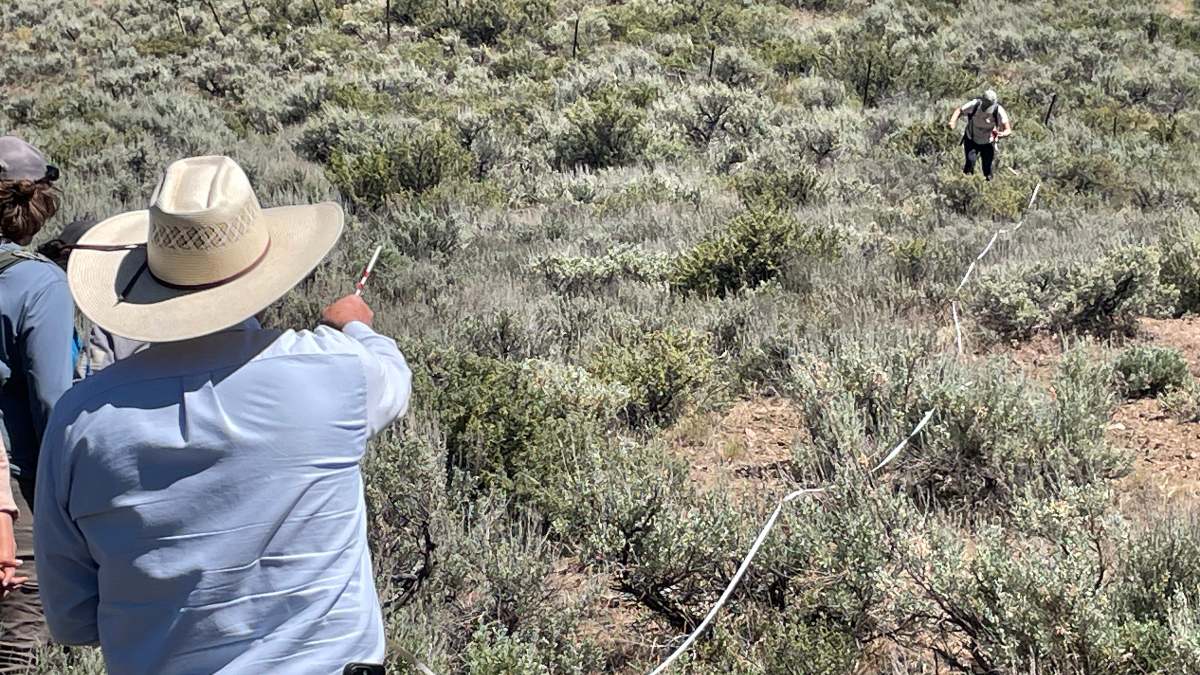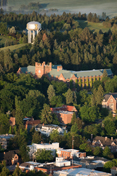Research Cowboys
July 24, 2024
Campfire conversations are a melding of ranch life and scientific research at University of Idaho’s Rinker Rock Creek Ranch in the Wood River Valley.
Banjo, a horse who throws temper tantrums like a toddler who missed a nap, is tough to manage but always good for a story. And a bold weasel they call Diesel is fast becoming the unofficial mascot of Cow Camp — the more rustic of the ranch’s two living areas. Trapping and ear-tagging rodents, songbird counts in riparian areas and the use of beaver dams by brooding sage grouse hens are also fodder for discussions.
Rinker Rock Creek Ranch is a unique rangeland research and outreach facility comprising 22,000 acres — including 10,400 acres of deeded land under U of I’s control — managed in partnership by the university, the Nature Conservancy and the Wood River Land Trust, with input from stakeholders who serve on an advisory board. Researchers from the College of Agricultural and Life Sciences and the College of Natural Resources use the ranch as a living laboratory for studying rangeland health.
During most summers since research began at the ranch in 2016, between 20 and 30 people have gathered over three days in June for a data monitoring blitz, during which they record data from throughout the uplands about the types of vegetation that are present. The blitz provides a long-term record of how the landscape is responding to factors such as experimental treatments, a changing climate and invasive species.
“We decided we needed good science to drive management, and that meant getting the data,” said Karen Launchbaugh, a professor of rangeland ecology. “We want to see if the whole landscape changes and track it. We also want to get people out here to experience the ranch, both the science side and the social side.”
The blitz has become an eagerly anticipated social event that draws an eclectic group of participants — including U of I graduate students, summer ranch-hand interns, faculty, stakeholders and partners representing several organizations — to a remote and scenic setting.
Those who spend a summer as seasonal interns at Cow Camp — or come for just a few days to partake in the monitoring blitz — find wildlife, picturesque sunsets and starry nights more than offset what they miss in power, running water and cell service.
By day, ranch hands tend to their herd while blitz participants head for the hills with clipboards and tape measures. Prior to the first blitz, plots were randomly selected throughout the ranch to monitor. Blitz volunteers visit a third of the plots every summer to set up transects — straight lines through the landscape along which plant species and vegetation measurements are documented at regular intervals, with accompanying photographs.
“We can see what happens when we have a hot, dry summer versus a cold, wet spring, and we can see how the vegetation responds to that each year,” explained Tim Prather, a professor in the Department of Plant Sciences and associate director of the Rangeland Center. “We’ve had instances where we’ve had a lot of different plant species — sometimes over 70. This year with it being both cool and dry, we did not see as many of our wildflower species.”
Launchbaugh provides volunteers with their reward for a hard day’s work — her famous Dutch oven cooking. From smoky prime rib and cobbler to loaded breakfast casseroles, Launchbaugh serves feasts that provide a welcome respite for Cow Camp residents accustomed to dining upon dry goods, in the absence of refrigeration. Launchbaugh sometimes contributes to the evening’s entertainment, strumming original songs with western themes, such as the lonely life of a Basque sheepherder.
Building good memories for her crew is as important to Launchbaugh as collecting sound scientific data.
“These interns we have now, they are working for other organizations and they’re building relationships and learning about this land,” Launchbaugh said. “This will be part of their memory. Someday they’ll come here with their kids and they’re going to say, ‘Once I was part of this blitz.’”
Matt Mikelson, of Parma, discovered his invitation to spend a summer as a cowboy intern while perusing a job board at the College of Southern Idaho, where he’s studying animal science. He’s fixed a lot of fencing this summer and is especially proud of the corrals he welded. He’s gotten to toss a lasso a few times, but his days are mostly spent distributing salt mixtures and minerals for livestock and otherwise “making sure the cows are good and happy.”
“I like the remoteness of Cow Camp. It’s pretty cool. I like the outdoor shower,” Mikelson said, drawing laughs from his peers. “The wall tents are pretty cool. They can either get to like 20 degrees or 103 degrees. It just depends.”
Some of the student researchers begin their days well before sunrise. For example, Annie Vaage, a U of I undergraduate from Orofino studying wildlife resources, wakes at 4 a.m. each morning to listen for songbirds at selected points along Rock Creek, recording the species she confirms at each location. Her hypothesis is that species diversity will be greatest near beaver dams and manmade structures that mimic them, known as beaver dam analogs.
Harrison Eckard-Garrett, of Des Moines, Iowa, is a field technician working on a small mammal research project with U of I master’s student Kirby Lau, of Hillsborough, North Carolina. The two leave Cow Camp before sunrise to affix rodents they capture in hundreds of traps with tiny ear tags. Ear-tagging enables them to track the rodents’ range for a study on secondary effects of a herbicide used for controlling annual invasive grasses.
“It can be pretty different for folks who grew up living in a city or a suburb to come spend a summer living in a wall tent, cooking outdoors, meeting folks from Idaho and watching the cattle get moved by folks on horseback,” said Cameron Weskamp, Rinker Rock Creek Ranch operations manager. “It’s rustic. It’s beautiful. It’s quiet. There’s no cell service, which is a blessing and a curse, depending on whom you ask. I think it can be eye-opening.”

About the University of Idaho
The University of Idaho, home of the Vandals, is Idaho’s land-grant, national research university. From its residential campus in Moscow, U of I serves the state of Idaho through educational centers in Boise, Coeur d’Alene and Idaho Falls, nine research and Extension centers, plus Extension offices in 42 counties. Home to more than 12,000 students statewide, U of I is a leader in student-centered learning and excels at interdisciplinary research, service to businesses and communities, and in advancing diversity, citizenship and global outreach. U of I competes in the Big Sky and Western Athletic conferences. Learn more at uidaho.edu.






